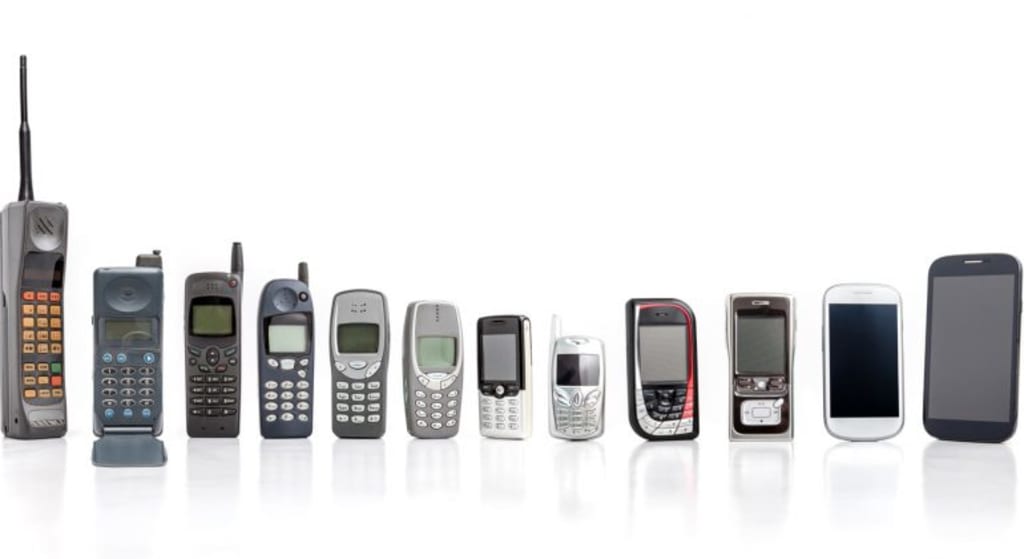The Evolution of Mobile Phones: From Brick-Sized Devices to Modern Smartphones
"Tracing the Journey of Mobile Phones: A Technological Revolution from Bricks to Smartphones"

Cell phones have come a long way since their inception in the 1980s. It was originally a large and bulky device used to call. However, with the advancement of technology, mobile phones have gone through many changes. It has evolved from the brick-sized device of the past to the sleek, multi-functional device we call a smartphone.
Let's go through the evolution of the mobile phone and learn how it has changed over the years.
The first cell phone
In 1973, Motorola released its first cell phone, the DynaTAC 8000x. It was a large instrument, weighing about two and a half pounds and about 10 inches long. It is a simple device that only allows users to make calls and has a battery life of only 30 minutes.
First flip phone
In the 1990s, the first flip phones were introduced. It was the Motorola StarTAC, a smaller and more portable convertible. It is also the first phone to have vibrating notifications and a lithium-ion battery that improves battery life.
First camera phone
In 2000, Sharp introduced the world's first camera phone, the J-SH04. It has a small camera that can take low-resolution photos and is a milestone in the evolution of mobile phones.
The emergence of smartphones
In the mid-2000s, smartphones began to gain popularity. It is a device that combines the functionality of a phone with the functionality of a computer. They have larger screens, more powerful processors, and can connect to the Internet, allowing users to browse the Internet, check email, and use various applications.
The first iPhone
In 2007, Apple introduced the first iPhone, which revolutionized the smartphone industry. It has a large touchscreen display, a sleek design and an intuitive user interface. It is also the first phone to feature a multi-touch screen that allows users to pinch and zoom in on images.
The first Android phone
In 2008, the first Android phone was introduced by HTC. It's called the HTC Dream, also known as the T-Mobile G1. It was the first phone to run on the Android operating system developed by Google. The Android operating system is rapidly gaining popularity and is currently the most widely used mobile operating system in the world.
Evolution of the screen
Screens on cell phones have come a long way since the early days of cell phones. At first, they were small and uniform, but now they are large, high-resolution displays that can display images and videos in incredible detail.
The first touchscreens
In the early 2000s, touchscreens became popular on mobile phones. These were first used in devices such as the Palm Treo and BlackBerry Storm, but it was the iPhone that made them popular.
The evolution of the camera
Cameras on cell phones have also improved significantly over the years. At first, it was a low-resolution camera that could only take basic photos, but now there are high-resolution cameras that can take photos and videos that rival professional cameras.
The first front-facing camera
In 2003, the first front-facing camera was introduced in the Sony Ericsson Z1010. It allows users to take selfies and video calls.
First dual camera setup
In 2011, the HTC Evo 3D introduced the first dual-camera setup. It allows users to take 3D photos and videos.
The first triple-camera setup
In 2018, the Huawei P20 Pro introduced the first triple-camera setup. It allows users to capture stunning photos and videos with great detail.
Evolution of battery life
One of the biggest problems with cell phones is battery life. Early cell phones had short battery life and required frequent charging. However, battery life has improved significantly as battery technology has improved.
The first lithium-ion battery
In 1991, the first lithium-ion battery was introduced. It is smaller and more efficient than previous battery technology, allowing mobile phones to have longer battery life.
Introduction to Energy Bank
As cell phones became more popular, power banks were introduced. Portable battery packs that allow users to charge their phones anywhere have become an essential accessory for many smartphone users.
The evolution of communication
Mobile phones have also evolved in terms of connectivity. At first, they only allowed users to make calls and send text messages, but now they are connected to the Internet, allowing users to access the Internet and use various applications.
Introducing 3G and 4G
In the mid-2000s, 3G networks were introduced, allowing mobile phones to connect to the Internet at faster speeds. In the early 2010s, the 4G network was introduced, allowing for fast internet speeds.
Introduction of Wi-Fi
In the mid-2000s, cell phones introduced Wi-Fi connectivity. It allows users to connect to Wi-Fi networks and access the Internet without using their mobile data.
The evolution of security
Cell phones have also evolved in terms of security. Initially, there were no security features, but now there are several security features to protect user data.
Enter the password
Passwords were the first security features introduced in mobile phones. Users can set a password to unlock the phone and protect their data.
Introducing the fingerprint sensor
In the mid-2010s, mobile phones introduced fingerprint sensors. They allow users to unlock their phone with their fingerprints, a more secure and convenient way to unlock their phone.
Facial recognition
In the late 2010s, mobile phones introduced facial recognition. This allows users to unlock their phone using their face, a more convenient way to unlock their phone.
The results
The evolution of mobile phones has been amazing. From the brick-sized devices of the past to today's modern smartphones, mobile phones have undergone many changes. They have become essential tools that we use every day to communicate, access information, and interact with the world. As technology continues to evolve, it will be interesting to see how cell phones evolve in the future.





Comments
There are no comments for this story
Be the first to respond and start the conversation.